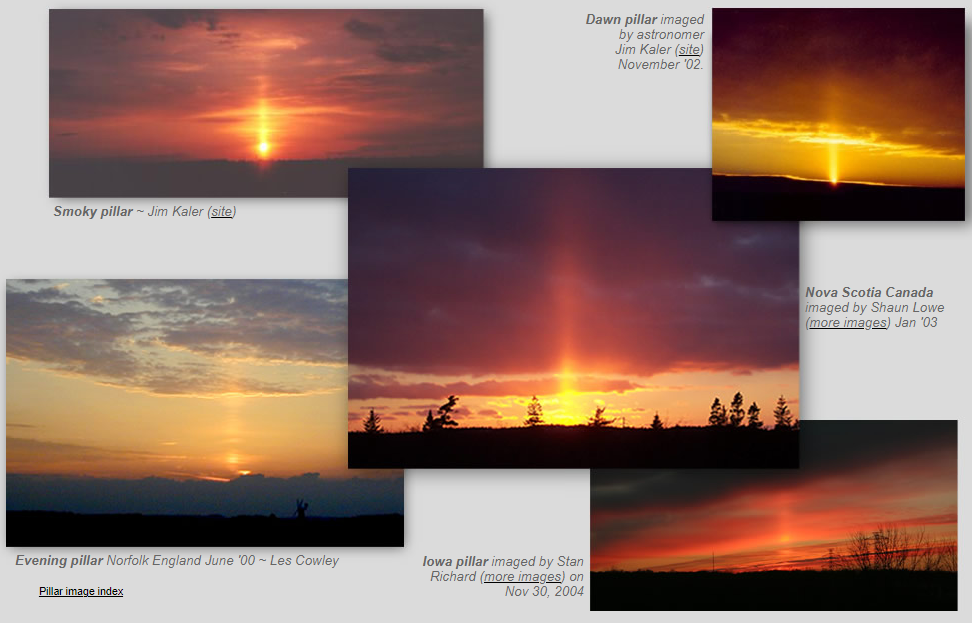Sun Pillars
Sun Pillars: A Dazzling Atmospheric Phenomenon
Have you ever looked up at the sky and noticed a vertical beam of light extending from the sun? This captivating sight is known as a sun pillar. Sun pillars are a fascinating atmospheric optical phenomenon that occurs when sunlight reflects off the surfaces of ice crystals in the atmosphere. While the basic concept of sun pillars is relatively simple, there are several intriguing aspects to explore. In this article, we will delve deeper into the phenomenon of sun pillars, uncovering their formation, characteristics, and the conditions required for their occurrence.
The Formation of Sun Pillars
Sun pillars are created when sunlight interacts with horizontally-oriented ice crystals present in the Earth's atmosphere. These crystals can be found in high-altitude clouds, such as cirrus clouds, or even in falling snowflakes. As sunlight passes through these ice crystals, it undergoes a process called refraction. Refraction causes the light to change direction and separate into its constituent colors, similar to how a prism splits white light into a rainbow.
The ice crystals responsible for sun pillars typically have a flat, plate-like structure. When these crystals align horizontally, they act as tiny mirrors, reflecting sunlight vertically. This reflection creates the appearance of a vertical beam of light extending above or below the sun. The length and intensity of the pillar depend on various factors, including the position of the sun, the size and shape of the ice crystals, and the observer's viewpoint.
Characteristics of Sun Pillars
Sun pillars are characterized by their vertical orientation and their vibrant colors. The pillar appears as a narrow column of light extending upwards or downwards from the sun, resembling a glowing pillar in the sky. The colors of the pillar often mirror those of a sunset or sunrise, ranging from red and orange to pink and purple. These colors result from the scattering of sunlight by the ice crystals, similar to how a sunset's hues are produced.
The height of a sun pillar can vary, ranging from a few degrees to several degrees above or below the sun. In some cases, multiple pillars may be visible simultaneously, creating a stunning display of parallel beams of light. Additionally, sun pillars can be accompanied by other atmospheric optical phenomena, such as halos, which further enhance the spectacle.
Conditions for Sun Pillar Formation
Several conditions must be met for the formation of sun pillars. First and foremost, the presence of high-altitude clouds or falling snowflakes is necessary, as these provide the required ice crystals. The crystals must be horizontally oriented, aligned in such a way that they reflect sunlight vertically. Additionally, the angle at which the sunlight enters the crystals plays a crucial role in determining the size and intensity of the pillar.
The optimal conditions for observing sun pillars occur during cold winter days when the air is saturated with moisture. These conditions allow for the formation of ice crystals in the atmosphere, which are essential for creating sun pillars. However, sun pillars can also occur in other seasons, especially in regions with colder climates or at higher latitudes.
Observing Sun Pillars
To witness a sun pillar, one must position themselves so that the sun is low on the horizon. This positioning allows for a greater angle between the observer and the ice crystals, maximizing the chances of seeing a pillar. While sun pillars are most commonly observed during sunrise or sunset, they can occasionally be seen during other times of the day when the sun is low enough.
When observing a sun pillar, it is important to note that its appearance may change as you move. This phenomenon occurs due to the relative positions of the ice crystals and the observer. As you change your viewpoint, the angle at which sunlight enters the crystals also changes, altering the size and shape of the pillar. Thus, moving around while observing a sun pillar can provide different perspectives and reveal its dynamic nature.
Capturing the Beauty of Sun Pillars
Photographing sun pillars can be a rewarding experience, as it allows you to preserve the beauty of this captivating phenomenon. To capture the best possible image, it is recommended to use a camera with manual settings. Adjusting the exposure and white balance can help enhance the colors and details of the pillar. Additionally, using a tripod can ensure stability and sharpness in your photographs.
When photographing sun pillars, consider including other elements in the frame, such as trees, buildings, or landscapes. These elements provide context and add visual interest to your images. Experiment with different angles and compositions to create unique and visually appealing photographs.
Conclusion
Sun pillars are a stunning atmospheric optical phenomenon that never fails to captivate observers. Formed by the reflection of sunlight off horizontally-oriented ice crystals, these vertical beams of light create a mesmerizing display in the sky. Understanding the formation, characteristics, and conditions for sun pillars allows us to appreciate the intricate beauty of this natural phenomenon. Whether you witness a sun pillar during a tranquil sunrise or a vibrant sunset, take a moment to savor the magic of the sky and the wonders it unveils.

Note: this article has been automatically converted from the old site and may not appear as intended. You can find the original article here.
Reference Atmospheric Optics
If you use any of the definitions, information, or data presented on Atmospheric Optics, please copy the link or reference below to properly credit us as the reference source. Thank you!
-
<a href="https://atoptics.co.uk/blog/sun-pillars/">Sun Pillars </a>
-
"Sun Pillars ". Atmospheric Optics. Accessed on July 27, 2024. https://atoptics.co.uk/blog/sun-pillars/.
-
"Sun Pillars ". Atmospheric Optics, https://atoptics.co.uk/blog/sun-pillars/. Accessed 27 July, 2024
-
Sun Pillars . Atmospheric Optics. Retrieved from https://atoptics.co.uk/blog/sun-pillars/.